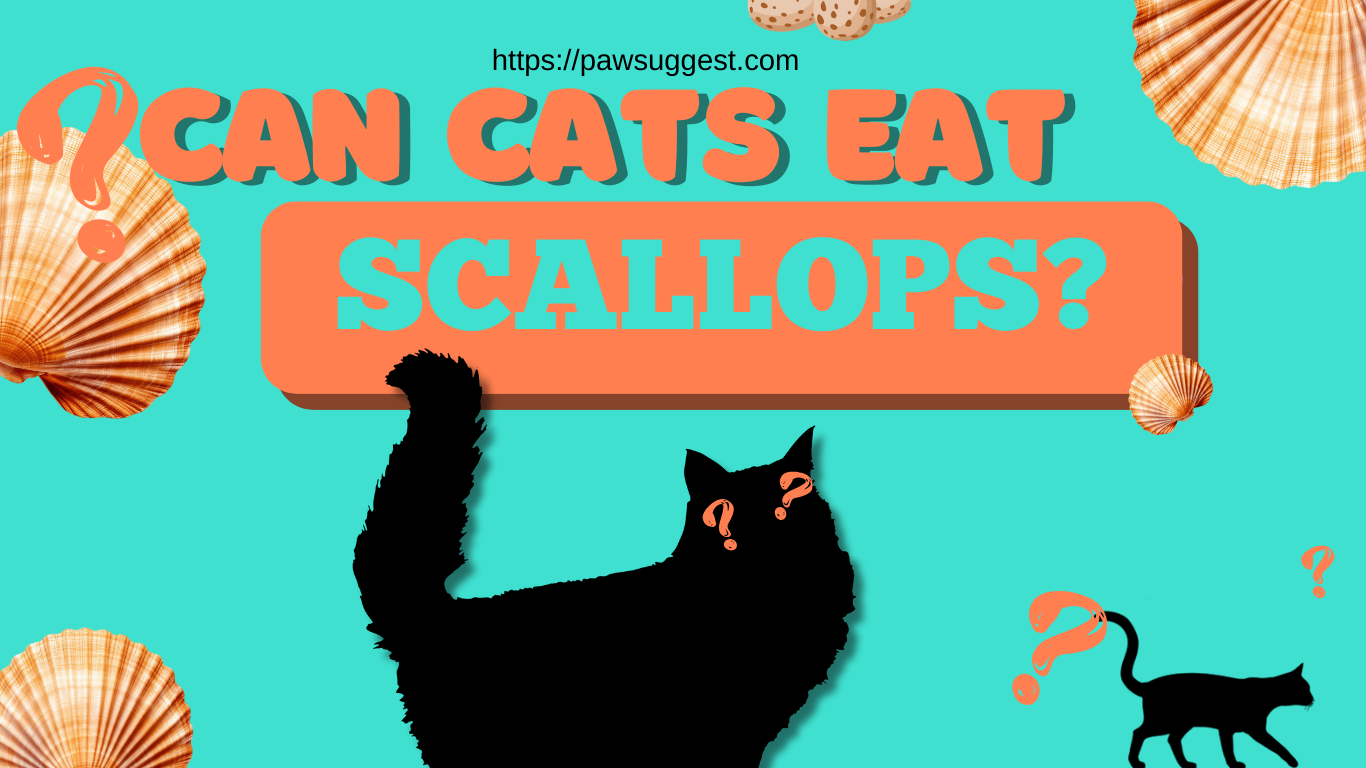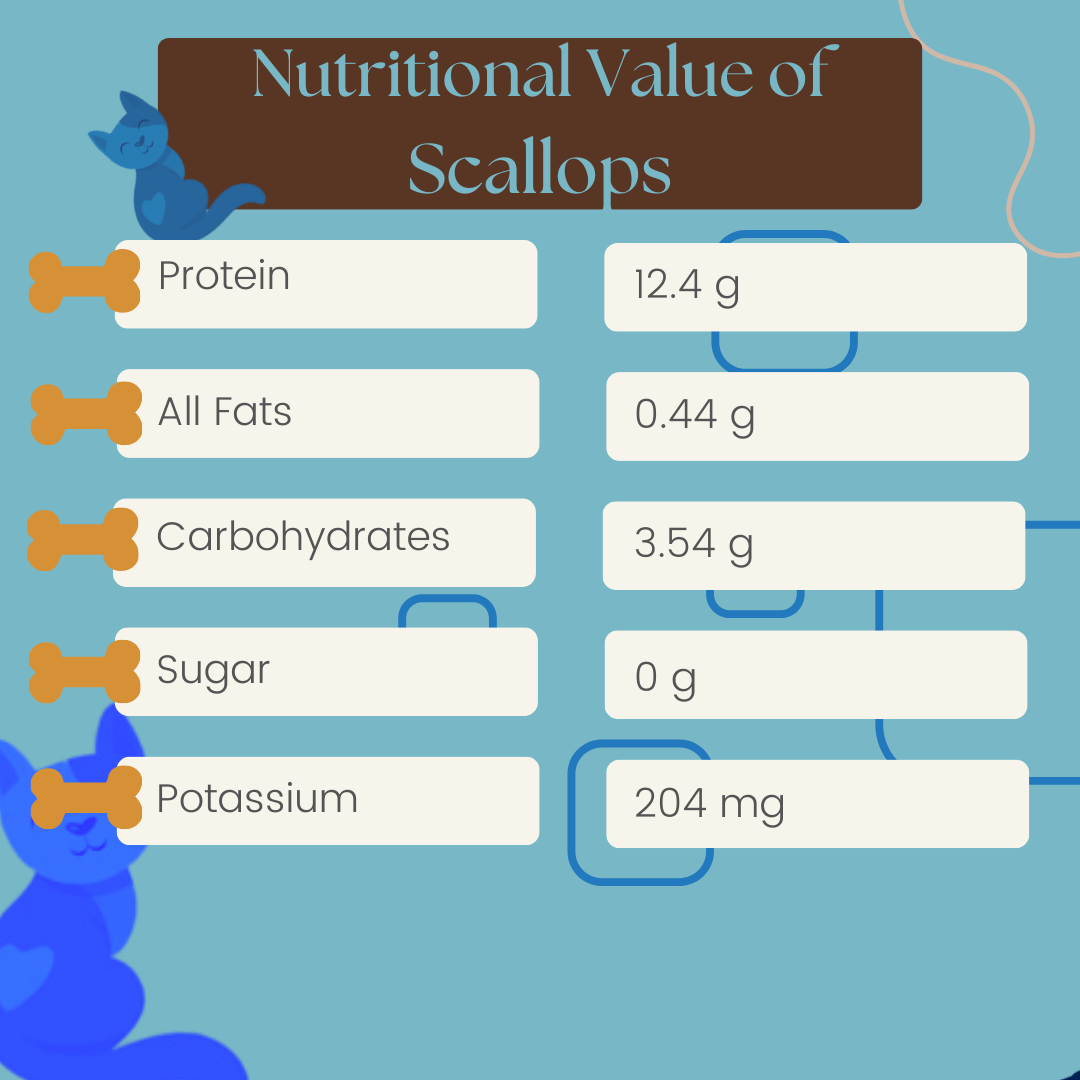Cats consuming fish and other seafood are famous, but you might be concerned about their safety. While scallops are a common and healthy food for humans, what about cats?
Are scallops safe for cats to eat? For them, is it healthy?
The answer is simple: Yes!
Thankfully, if scallops are thoroughly cooked, cats can eat them, but there are a few things to keep in mind.
It is best to speak with your veterinarian before adding any new food to your cat’s diet, though.
All the information you require to feed your cat scallops is provided in the article given below. So, without wasting more time, let’s go!

What are Scallops? Can Cats Eat Them?
Scallops are shellfish from the bivalve mollusk family, together with clams, mussels, and oysters. Their meat is soft and succulent, and their shells have a unique fan form that makes them popular. People sometimes get confused between scallops and clams, but they are different. To know about clams, click here!
All across the world, scallops can be found in shallow waters near sandy or gravelly seafloors. They are widely used in many different cuisines and are typically grilled, baked, or seared.
Scallops can be eaten separately as a main course or added to salads, pasta meals, stews, and seafood soups.
And speaking of cats, how appropriate are scallops for our furry friends?
Can Cats Eat Scallops?
Let’s have a look at the nutritional value of scallops before moving forward:

Scallops eaten raw may make you sick. They may be carriers of Salmonella bacterium. It’s imperative to ensure that any scallops you feed your cat are cooked through and haven’t gone spoiled.
Raw Scallops
Giving raw food to your cat is not a good idea because uncooked scallops have a high potential of containing salmonella. It can sicken a cat.
When scallops are collected from contaminated water, heavy metals including lead, arsenic, cadmium, and mercury can build up in them.
There is a good risk that these compounds will turn out to be poisons that are harmful to cats. It also contains thiaminase, which can cause foodborne illnesses.
Cooked Scallop
Cats should only be served cooked scallops. We know that boiling and steaming kills bacteria and parasites, making it a healthier option.
Cooked scallops prevent thiaminase from breaking down vitamin B1, ensuring that a cat won’t have any deficiency problems.
Remember that when you talk about cooked scallops, you shouldn’t add any sauces, onions, garlic, or other ingredients.
Most of the time, it can upset a cat’s digestive system, which frequently results in diarrhea and vomiting.
Can Cats Get Allergies From Scallops?
Since cats often cannot eat seafood, they can develop allergies to scallops. Some of them are given below:
- Itching
- Lethargy
- Redness
- Vomiting
- Hair loss
- Diarrhea
Generally, these allergies last for two or more days before going away. But if they don’t, you should take your cat to the vet right away.
Benefits of Adding Scallops to Your Cat’s Diet
Many people doubt the benefits of feeding scallops to cats due to the health benefits associated with it.
Here, we’ll learn about a few of these long-term advantages that may be useful.
● High-Quality Protein Source:
Protein, which is vital for preserving your cat’s general health, is abundant in scallops. In addition to maintaining healthy fur and skin, protein aids in the development and repair of muscles and keeps your cat feeling content and full.
● Vitamin B12
The vital ingredient that a kitty needs for its mental system and digestive system is vitamin B12. Their cognitive system must also remain sound and functional.
It is essential and needs to be administered precisely to balance off everything that enters their body.
● Omega3
Omega-3 fatty acids found in scallops offer anti-inflammatory qualities, making them a fantastic option for cats with dry skin or allergies. They can also be used to relieve hotspots.
● Potassium
In the event that your cat is potassium deficient, potassium normally serves as a supplement. It is also necessary for the major bodily processes that the muscles and nerves carry out.
Potassium deficit causes disruption of important organs, so it is essential to keep your cat safe from any fatal events.
How to Cook Scallops for Cats
Follow these easy steps to make your cat a delicious and safe scallop dish:
- Take a standard cooking pan and heat it up to a high temperature.
- Take the raw scallops out of the fridge.
- Sear the scallops in a heated pan, turning them over every minute to ensure a uniform sear.
- To make sure the scallops are cooked through and safe for your cat, cook them for a total of 4-5 minutes.
- To ensure that the scallops are cooked all the way through, use a cooking thermometer. Their core temperature should ideally reach 115 degrees Fahrenheit. But be aware that searing the scallops on high heat may cause them to retain heat, raising their internal temperature to between 125 and 130 degrees Fahrenheit.
- To serve the scallops to your cat, chop them into tiny, bite-sized pieces.
Frequently Asked Questions (FAQs)
● Can cats be allergic to scallops?
Yes, allergies to specific foods, including shellfish like scallops, can develop in cats just like in people. It’s critical to keep a watchful eye out for any indications of an allergic reaction in your cat. It includes itching, vomiting, or diarrhea.
● How should scallops be prepared for cats?
If you do decide to give your cat a taste of scallops, make sure they are cooked all the way through and aren’t flavored or artificially added.
The safest option for feeding to cats is scallops that are simple, boiled, or grilled without any additional salt or seasonings.
● Are there any alternatives to feeding scallops to cats?
There are many different delicacies you may give your cat as an occasional treat, even though scallops might not be the ideal option for their diet.
Try products like cat-specific fish or fried chicken to satisfy your cat’s desires without sacrificing their health.
Final Thoughts
In addition to this article, we now know that scallops are toxic-free and can be fed to cats as an extra food source.
Seafood, including scallops, should always be introduced cautiously to your cat and should never take the place of a diet that is suited for them.
We have, however, also arrived at the end. To avoid interfering with the body’s natural supply of nutrients, serving the scallops cooked without additional preservatives is preferable.
Alright, so when did you feed your cat scallops for the first time? How did it respond?
Comment down!

